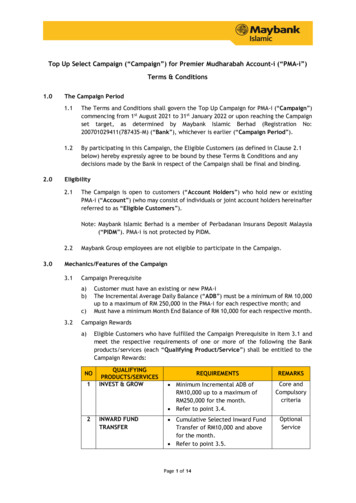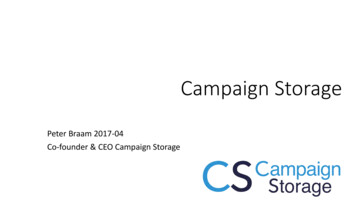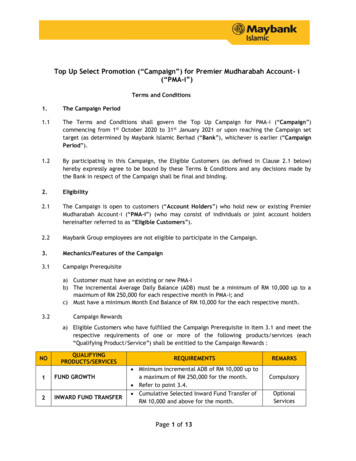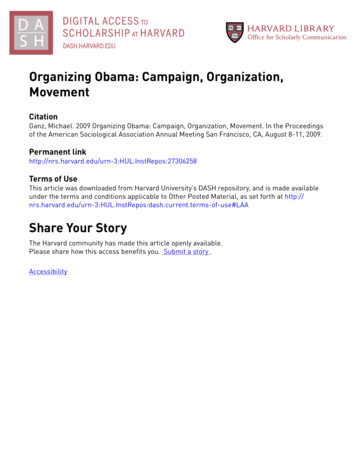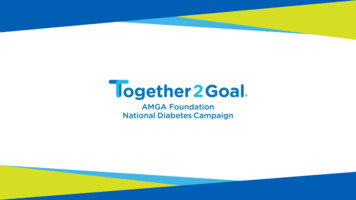
Transcription
Monthly Campaign WebinarAugust 16, 20182
Today’s Webinar Together 2 Goal Updates––––Webinar Reminders2019 Acclaim Award ApplicationNational Day of Action2018 Institute for Quality Leadership (IQL) Diabetes and Obesity– Timothy Garvey, M.D. of University ofAlabama Birmingham Q&A– Use Q&A or chat feature 2018 AllAll rightsrights reservedreserved 20183
Webinar Reminders Webinar will be recorded today andavailable the week of August 20th– www.Together2Goal.org Participants are encouraged to askquestions using the “Chat” and“Q&A” functions on the right side ofyour screen 2018 AllAll rightsrights reservedreserved 20184
2019 Acclaim Award ApplicationApplications Due September 21Honors the nation's premier healthcare deliveryorganizations that are high performing: Measurably improving the quality and value of care Improving patient experience and outcomes Continuously learning and innovating Improving population healthContact Sunny Temesgen at stemesgen@amga.org formore information. 2018 AllAll rightsrights reservedreserved 20185
National Day of ActionNovember 8, 2018T2G Talk & Taste Watch and discuss our two-minuteprovider video over breakfast or lunchand your meal is on us!In mid-September, we’ll providedownloadable kits with all the materialsyou’ll need.Let us know if your team plans toparticipate—email your name,organization name, and T2G Talk & Tastedate to together2goal@amga.org. 2018 AllAll rightsrights reservedreserved 20186
2018 Institute for Quality LeadershipNovember 13-15, 2018San Antonio, Texas Together 2 Goal Peer-to-PeerBreakout Session: Taking Diabetes toHeart: Finding Value in the MedicarePopulationRegistration now open atamga.org/IQL18 2018 AllAll rightsrights reservedreserved 20187
Today’s Featured PresenterW. Timothy Garvey, M.D., FACEProfessorDepartment of Nutrition SciencesUniversity of Alabama at BirminghamDirector, UAB Diabetes Research Center 2018 AllAll rightsrights reservedreserved 20188
Diabetes and ObesityTogether 2 Goal WebinarAugust, 2018W. Timothy Garvey, MD, FACEProfessorDepartment of Nutrition SciencesUniversity of Alabama at BirminghamDirector, UAB Diabetes Research Center
Rising Rates of Obesity but Not Overweight in US 0Note: Age-adjusted by the direct method to the year 2000 US Bureau of the Census using age groups 20–39, 40–59, and 60–74 years. Pregnant females excluded. Overweight defined as 25 BMI 30; obesity defines BMI 30;extreme obesity defines as BMI 40.Centers for Disease Control and Prevention. National Health and Nutrition Examination Survey (NHANES) data.
Number (in Millions) With Diagnosed Diabetes,United States, 1980–200920Number (millions)1816141210864208183 8587 89 91 93 9597 99 01YearCivilian, Non-Institutionalized PersonsCenters for Disease Control and Prevention. NHANES Data. Updated April, 2011.03 05 0709
Prevalence Rates for Diabetes, 2007MMWR 58:1259, 2009Prevalence Rates for Obesity, 2007MMWR 58:1259, 20090–7.07.1–8.18.2–9.09.1–10.5 10.6Prevalence Rates for Heart Disease 1997-2003CDC NCHS0–26.226.3–27.727.8–29.129.2–30.8 30.9Prevalence rates for Stroke 1997-2003CDC NCHS
The Spectrum of Cardiometabolic DiseasePrediabetic etabolic Syndrome Waist blood pressure fasting glucose Triglycerides HDL-cholesterolType 2DiabetesCardiovascularDiseaseObesityIFG, impaired fasting glucose; IGT, impaired glucose toleranceGarvey WT, 2013
Metabolic Evolution of Type 2 DiabetesLate Phase InsulinSecretion1st Phase InsulinSecretionInsulinSensitivityFasting GlucosePre-DiabetesOvert Diabetes
Intensive Treatments and Increase in HbA1c Over TimeUnited Kingdom Prospective Diabetes Study (UKPDS)Median HbA1c (%)98ADA action7ADA (glyburide)Metformin60Upper limit of normal range (6.2%)036Time From RandomizationUK Prospective Diabetes Study (UKPDS 34) Group. Lancet. 1998;352:854-65.9 10
Type 2 Diabetes: Standard“Stepped” Approach to TreatmentStep 7 – Insulin and OADs (insulin sensitizers)Step 6 – Multiple Daily InjectionsStep 5 – BID Split/Mixed InsulinStep 4 – Bedtime NPH or Glargine Daytime OADStep 3 – Oral Antidiabetic Agents – Combination TherapyStep 2 – Oral Antidiabetic Agents – MonotherapyStep 1 – Education, Diet, Exercise, and HBGM
Pharmacological Actions of Diabetes Drugs SulfonylureasMeglitinidesGLP-1 agonistsDPP-4 inhibitorsGLP-1 agonistsAmylin analogsColesevelamAlpha-glucosidase inhibitorsThiazolidinedionesBETACELL GLP-1 agonistsDPP-4 inhibitorsINTESTINEALPHACELLKIDNEYLIVER olidinediones DeFronzo RA. Diabetes. 2009;58:773-795.GLP-1 agonistsBromocryptineWeight Loss Medications
TreatmentDifferentialEffects ofT2DMTreatmentsEffect onWeightRisk ofHypoglycemia Insulin Sulfonylureas Thiazolidinediones Glinides DPPIV Inhibitors Colesevelam Bromocriptine α-glucosidase Inhibitor Metformin GLP-1 Agonists SGLT2 Inhibitors Lifestyle TherapyLifestyle Weight LossMedication
Evolution of Diabetes Therapy‘The Old Days’GOALSControlGlycemiaMedications Sulfonylurea Meglitinides Insulin(NPH, Regular)‘Ray of Light’‘New Dawn’‘The Future is now’GOALSGOALSGOALSReduced risk ofhypoglycemiaMinimalhypoglycemia;Weight neutral ormodest lossPrevent CVDeventsRenal protectionMedications Metformin TZDs Improvedbasal andrapid actinginsulinsMedications Metformin DPPIV inhib GLP-1 RA SGLT2 inhib Weight lossmedicationsMedications GLP-1 Agonists SGLT2 Inhibitors TZDs ? Weight lossmedications
What if there was a pill for T2DM that:1. Reduced HbA1c by 1-1.6% while other diabetesmedications were reduced in dosage or eliminated2. Led to a 10% decrease in body weight3. Reduced blood pressure by 6 mmHg systolic and 4mmHg diastolic4. Lowered triglycerides and raised HDL-c5. Was renal protective – decreasing albuminuria6. Improved sleep apnea7. Improved mobility and decreased pain8. Improved quality of lifeThis is the therapeutic profile of of weightloss therapy in T2DM
MedicationsTreatment of Obesity
Nutrition Management SummaryADA Recommendations CURRENT - 2013 Patients preferences are paramount Promote ‘health eating’ within the context of ‘meal patterns’: –Mediterranean, vegetarian, low fat, low CHO, DASH, Reduced energy intake while maintaining healthful eating pattern;“modest weight loss may provide clinical benefit’ Saturated fats 10%Recommendations are being revisited in 2018:Based on accumulating data, the expert panel will need to address theimportance of weight loss in patients with obesity, and MNT& DSE programsemphasizing reduced caloric intake; ‘healthy eating’ meal patterns can includelow carbohydrate diets.
The PREDIMED StudyEstruch R, Ros E, Salas-Salvadó J, et al and PREDIMED Study Investigators. N Engl J Med. 2013 Apr 4;368(14):1279-90. 7,447 people in Spain with high CVD risk randomized to Med Diet olive oil; Med diet nuts; control diet Decreased MACE outcome and all-cause mortality
Comprehensive Lifestyle Management Is the Foundation of Obesity TreatmentGarvey WT et al. Endocrine Practice 22(Suppl 3):1-203, 2016Meal Plan Reduced-calorie healthy mealplan 500-750 kcal daily deficit Many healthy meal planoptionsa Meal replacements Very-low–calorie diet is anoption for selected patients—requires supervisionTeam member/expertise:dietitian, health educatoraPhysical Activity Aerobic activity–Goal: 150 min/wk–3-5 days/wk Resistance exercise–Major muscle groups–2-3 times/wk Reduce sedentary behavior Individualized (e.g.,preferences, limitations)Team member/expertise:exercise trainer, physical activitycoach, physical/ occupationaltherapistAACE/ACE guideline lists: Mediterranean, DASH,low-carb, low-fat, volumetric, high protein, vegetarian.Behavior Interventional package ofbehavioral methods Self-monitoring; goal setting;education; problem-solving;stimulus control; stressreduction; psychologicalevaluation and treatment;cognitive restructuring;motivational interviewing;social support structuresTeam member/expertise: healtheducator, behaviorist, clinicalpsychologist, psychiatristAACE/ACE algorithm for the medical care of patients with ityAlgorithm.pdf.
Remember the Pathophysiology of Obesity:mechanisms protecting against weight lossIt is difficult for patients to maintain their weight loss over time.weight loss 40%-635/25/40%-70Sacks FS. et al. NEJM 2009;360(9) 859-873.612months1824
Regulation of Energy IntakeHypothalamic PathwaysPeripheral SignalsArcuate NucleusPVN, LHA, DMNOrexigenicPathwayGHRELINGSHRLEPTINHigher -1PEPTIDE NTRK2αMSHAnorexigenicPathwayGarvey WT, 2016.
In Obesity, biology protects against weight loss andmaintains a high body weightEquilibrium WeightWeight LossBaseline weight 250lbs Ghrelin Leptin, PYY,CCK, Amylin Resting energyexpenditure Hunger Calorie-densefood preferencesWeight GainIncreasedAppetiteDecreasedEnergy OutIncreasedEnergy InGarvey WT, 2014
Obesity PharmacotherapyAgentsActionApprovalPreviously availablePhentermine Sympathomimetic 1959Orlistat GI lipase inhibitor 1997Recently ApprovedUS s/cder/DrugsatFDA.Phentermine/Topiramate ER Sympathomimetic/Anticonvulsant(GABA receptor modulation?) Approved, Summer2012Lorcaserin 5-HT2C serotonin receptor agonist Approved, Summer2012Naltrexone ER/Bupropion ER Dopamine/noradrenaline reuptakeinhibitor/Opioid receptor antagonist Approved, September2014Liraglutide 3 mg GLP-1 receptor agonist ApprovedDecember 2014
Actions of Recently ApprovedWeight-Loss MedicationsArcuate NucleusPhentermineμ-ORGLP-1 RPOMC/CARTDecreasedAppetiteParaventricular NucleusLiraglutide 3 mg -MSHHigherCorticalCentersMC4RGABA?Dopamine/NE ionSerotonergicNeuronsMC4R, melanocortin 4 receptor.GABA, gamma-aminobutyric acid.POMC/CART, pro-opiomelanocortin/cocaine- and-amphetamine-regulated transcript.Courtesy of Dr. W. Timothy Garvey, 2014.
AACE Comprehensive Clinical Practice Guidelines for the Medical Care of Patients with ObesityGarvey WT et al. Endocrine Practice 22(Suppl 3):1-203, 2016
Garvey WT et al. Endocrine Practice 22(Suppl 3):1-203, 2016
Intensive Intervention in T2DM:Weight Regain over 4 Years in Look AHEADLook AHEAD Trial (N 5145)0-1.1%Reduction in initialweight (%)-2Diabetes support and educationIntensive lifestyle intervention-4P 0.0001-4.7%-6Retention at 4 years:ILI 94.1%DSE 93.1%-8-10012YearsILI, intensive lifestyle intervention; DSE, diabetes support and education.Look AHEAD Research Group. Arch Intern Med. 2010;170:1566-1575.34
Effect of Weight Loss in T2DM on CV Risk Factors and Diabetes MeasuresLook AHEAD Trial (N 5145)At 1 yearDSEILIWeight loss (%)-0.7-8.6A1C (%)-0.14-0.64*FPG (mg/dL)-7.2-21.5*% on diabetes medications2.2-7.8*Systolic BP (mm Hg)-2.8-6.8*Diastolic BP (mm Hg)-1.8-3.0*LDL-C (mg/dL)-5.7-5.2HDL-C (mg/dL)1.43.4*-14.6-30.3*TG (mg/dL)*P 0.001, †P 0.01 vs customary support.BP, blood pressure; CV, cardiovascular; DSE, diabetes support and education; ILI, intensive lifestyle intervention; T2DM, type 2 diabetes mellitus.Look AHEAD Research Group. Diabetes Care. 2007;30:1374-1383. Look AHEAD Research Group.Arch Intern Med. 2010;170:1566-1575.
One‐year Weight Losses in the Look AHEADStudy: Factors Associated With SuccessWadden TA et al. One‐year Weight Losses in the Look AHEAD Study: Factors Associated With Success. 17(4):713-722, 2012
Change in risk factors by weight loss categoriesfor the Look AHEAD cohort.HbA1c(Δ%)Weight LossCategoriesFastingGlucose(Δ mg/dl) 2% 2% to -2%-2% to -5%-5% to -10%-10% to -15%DBP and SBP(Δ mmHg)HDL and LDL(Δ mg/dl)Wing R R et al. Diabetes Care 2011;34:1481-1486Triglycerides(Δ mg/dl)HDL and LDLno lipid meds(Δ mg/dl)- 15%
Primary care-led weight management for remissionof type 2 diabetes (DiRECT): an open-label, clusterrandomised trialLean ME, Leslie WS, Barnes AC, Brosnahan N, Thom G, McCombie L, Peters C,Zhyzhneuskaya S, Al-Mrabeh A, Hollingsworth KG, Rodrigues AM, Rehackova L,Adamson AJ, Sniehotta FF, Mathers JC, Ross HM, McIlvenna Y, Stefanetti R, TrenellM, Welsh P, Kean S, Ford I, McConnachie A, Sattar N, Taylor R.Lancet 391(10120):541-551, 201823 practicesintervention49 generalpractices306 T2DM patientsenrolled26 practicescontrol VLCD for 3 months using mealreplacements Structured food reintroduction for 2months Weight loss maintenance 7 months Standard care in UK for 12 months
DIRECT Study: ResultsParameter/OutcomeIntervention Group Control GroupWeightHbA1cNumber DiabetesMedicationsNumber Blood PressureMedicationsTriglyceridesQuality of Life 10.0 kg 0.9% 0.8 1.0 kg 0.1% 0.2 0.6 0.1 0.31 mmol/L 7.2 0.09 mmol/L 2.9Lean ME et al. Lancet 391(10120):541-551, 2018
DIRECT Study:Weight loss anddiabetes remissionin primary carepracticesLean ME et al. Lancet391(10120):541-551, 2018
How to Manage a Very Low Calorie Diet 800 1,000 kcal/day to begin Begin with meal replacements 3-5 X/day for 1-3 months Transition to one regular-food, portion-controlled meal plus 2meals/day consisting of replacements Requires support, coaching, group sessions Education and behavioral interventions to promote persistinglong-term changes in eating behavior medical monitoring especially in patients with diabetes: e.g.,stop insulin secretagogs and reduce basal insulin in half,monitor for hypoglycemia Avoid in patients with renal insufficiency, advance liver disease,pregnancy, breast feeding, active malignancy, recent CVD event,psychiatric disorders
Treatment of Diabetes Using Weight Loss MedicationsDiabetes RCTAgentsActionOrlistat GI lipase inhibitor Phentermine/Topiramate ER Sympathomimetic/Anticonvulsant(GABA receptor modulation?) Lorcaserin 5-HT2C serotonin receptor agonist NaltrexoneSR/Bupropion SR Dopamine/noradrenaline reuptakeinhibitor/Opioid receptor antagonist Liraglutide highdose (3 mg/day) GLP-1 receptor agonist ER, extended release; GABA, gamma-aminobutyric acid; GI, gastrointestinal; GLP, glucagon-like peptide.
Effects of Phentermine/Topiramate ER in T2DMWeeks*0481216202428323840444852ITT–LOCF56LS Mean WeightLoss 40444852ITT–LOCF56LS Mean Change inHbA1c (% n/TPM ER 15/92†P , 0.0001 for PHEN/TPM ER groups vs. placebo at all time points except week 0. ‡P , 0.05 vs. placebo.Garvey WT et al, Diabetes Care, ePub Sept 23, 2014-1.2(-13.1)-1.6(-17.5)
Effects of Phentermine/Topiramate ER in T2DM705.56053*Percentage of SubjectsAchieving HbA1c GoalsChange inDose/Number ofDiabetes Meds18.750404032*29.130162021.310300HbA1c 7.0%HbA1c 6.5%( 53 mmol/mol) ( 48 mmol/mol)Placebo (n 55)PHEN/TPM ER 15/92 (n 75)*P , 0.05 vs. placeboGarvey WT et al, Diabetes Care, ePub Sept 23, 201420100102030Subjects (%)Decreased No. ofAntidiabetic MedicationsIncreased No. of AntidiabeticMedications
Phentermine/Topiramate ER Effect on RiskFactors: CONQUER StudyVariablePhentermine/Topiramate ER7.5/46 mgPlaceboPvalueWaist (cm) -7.6-2.4 0.0001Systolic BP (mm Hg) -4.7-2.40.0008-3.4-2.70.1281-8.64.7 0.0001-3.7-4.10.7391Diastolic BP (mm Hg)Triglycerides (%) LDL–C (%)HDL–C (%) 5.21.2 0.0001CRP (mg/L) -2.49-0.79 0.0001Adiponectin (µg/mL) 1.400.33 0.0001Changes from baseline to week 56 in secondary endpointsGarvey WT et al. Am J Clin Nutr. 2012;95(2):297-308.
Effects of Naltrexone/BupropionER of weight and HbA1c inPatients with Type 2 DiabetesHollander P et al. Diabetes Care 2013;36:4022-4029
Diabetes Prevention Program StudyInterventionsEligible participantsRandomizedStandard lifestyle recommendationsLifestyle(n 1079)The DPP Research Group. N Engl J Med. 2002;346:393-403.Metformin(n 1073)Placebo(n 1082)
Mean Weight Change during DPPWeight change (kg)0PlaceboMetformin-2Lifestyle-4-6-80123Years from RandomizationThe DPP Research Group. N Engl J Med. 2002;346:393-403.4
Incidence of Diabetes during DPPAll ParticipantsPlacebo (n 1082)Metformin (n 1073)Lifestyle (n 1079)Cumulative incidence (%)4030Risk reduction31% by metformin58% by lifestyle20100012Years from randomizationThe DPP Research Group. N Engl J Med. 2002;346:393-403.34
How much weight loss is needed to preventtype 2 diabetes? The DPP experienceIncidence rate per 100 person-years20151050-10-50Change in weight from baseline (kg)Redrawn from: Hamman, et al Diabetes Care 29:2102-2107, 2006 5
Phentermine/Topiramate ER and the Prevention ofDiabetes in Patients With Metabolic Syndrome and/orPrediabetes: SEQUEL Study12Placebo11PHEN/TPM ER 7.54/4610Cumulative IncidenceRate of Type 2DiabetesPHEN/TPM ER 15/9298765432100 412202836445260WeeksGarvey WT et al. Diabetes Care. 2014;37:912-921.68768492 100 108
Dose-Response for Weight Loss and Diabetes Preventiondue to Phentermine/Topiramate ER Treatment: SEQUELAnnualized Diabetes Incidence Rate %8.07.06.05.04.03.02.01.00.0 5% 5 to 10% 10 to 15%Weight Loss CategoryGarvey WT et al. Diabetes Care. 2014;37:912-921. 15%
Cumulative DiabetesIncidence (%)Treatment ofPatients withPrediabetes withLiraglutide 3mg/dayGlucoseLe Roux CW etal. Lancet389:1399, 2017Insulin
Cardiometabolic Disease Staging (CMDS)Stage8CriteriaRationale01No Risk FactorsHealthy Obese 11 or 2 Risk Factors(waist, blood pressure,triglycerides, HDL-c)Metabolic Syndrome has lowsensitivity for CMD, and 1 or 2 riskfactors elevates risk of future T2DMand CVD 2,32Metabolic Syndrome ORPrediabetes(i) Metabolic Syndrome alone,OR (ii) IFG, OR (iii) IGTBoth Metabolic Syndrome andPrediabetes confer increased risk ofT2DM and CVD 3,43Metabolic Syndrome PLUSPrediabetes2 or more out of 3: MetabolicSyndrome, IFG, IGTRisk of future T2DM is double inpatients with both MetabolicSyndrome and Prediabetescompared with either alone 3-64End-Stage CardiometabolicDiseaseType 2 Diabetes and/or CVDT2DM is CVD risk equivalent 71. Wildman, Arch Intern Med 168:1617, 2008. 2. Liao, Diabetes Care 27:978, 2004. 3. Wilson, Circulation 112: 3066, 2005. 4.Lakka JAMA. 2002;288:2709, 2002. 5. Lorenzo, Diabetes Care 26:3153, 2003. 6. De Vegt JAMA 285:2109, 2001. 7. Haffner,N Engl J Med 339:229, 1998. 8. Guo F, Moellering DR, Garvey WT, Obesity 22:110, 2014
Cardiometabolic Disease Staging: CumulativeDiabetes Incidence as a Function of Increasing CMDSRisk Stage: CARDIA Study Cohort50Cumulative diabetes incidence(%)Stage 0, Metabolically healthyStage 1Stage 2Stage 34030201000Guo F, Moellering DR, Garvey WT.Obesity 22:110-118, 2014246810Follow-up time (years)12
Number needed to treat to prevent one case of T2D as a functionof baseline weighted cardiometabolic disease stagingCMDSscoreNumber needed to treat0–2925860 18Guo F, Garvey WT. Diabetes Care. 40(7):856-862, 2017CMDS, Cardiometabolic Disease Staging; T2D, type 2 diabetes
Together 2 Goal AMGADiabetes Focused National CampaignData Reporting Measures1.HbA1c Control2.Blood Pressure Control3.Medical Attention forNephropathy4.Lipid ManagementWeight Loss TherapyDSMES and MNT Programs shouldencompass a concerted plan forreduced calorie meal plans in patientswith overweight/obesity for optimaloutcomes
Thank You
September 2018 WebinarDate/Time: September 20, 2018 from 2-3pm EasternTopic: Removing Patient Barriers to Medication AdherencePresenter: Molly Ekstrand, RPh, BCACP, AE-C of Park Nicollet HealthPartners CareGroup 2018 AllAll rightsrights reservedreserved 201860
Questions 2018 AllAll rightsrights reservedreserved 201861
W. Timothy Garvey, M.D., FACE. Diabetes and Obesity W. Timothy Garvey, MD, FACE Professor Department of Nutrition Sciences . Courtesy of Dr. W. Timothy Garvey, 2014. Actions of Recently Approved Weight-Loss Medications Arcuate Nucleus Paraventricular Nucleus POMC/ CART MC4R 5-HT 2C
